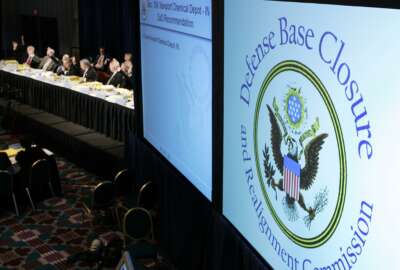
From a former Pentagon CFO, 10 suggestions for the incoming administration on DoD business reform
Given enough attention and commitment from the Pentagon’s top leadership, the next administration ought to be able to implement enough business reforms to wring...
Given enough attention and commitment from the Pentagon’s top leadership, the next administration ought to be able to implement enough business reforms to wring billions of dollars a year out of the Defense Department’s budget, said Robert Hale, who managed DoD’s finances for five years from 2009-2014.
Note that he says billions — not the tens of billions suggested by one Pentagon advisory report that’s gotten substantial media and congressional attention in recent weeks.
“I think it’s unrealistic to think that you’re going to get $20 or $30 billion worth of savings through changes in business practices — realistic changes, anyway,” Hale said during an interview for Federal News Radio’s On DoD. “A lot of things in life are 1 percent inspiration and 99 percent perspiration. I think the Defense Business Board gave some good ideas on the inspiration side, but it didn’t do a lot to help the department figure out how to actually implement the 99 percent. There wasn’t a lot of linkage.”
He was referring to a 2015 report in which the board calculated that DoD’s administrative costs totaled about $134 billion per year and suggested the department could shave $125 billion from that spending over the next five years, chiefly by attrition in the civilian workforce and cutting service contracts.
In his own newly-published report for the Center for a New American Security, Hale, who’s now a fellow at Booz Allen Hamilton, offered a much more modest menu of cost-saving reforms for the incoming administration, but said achieving even those will require dogged attention from the Pentagon’s top leadership, including in some cases the secretary of Defense.
He acknowledged inefficiencies in the way DoD manages its workforce, but said Defense leadership can only begin to attack them once it has a better understanding — ideally through an independent, outside analysis — of the right mix between military personnel, Defense contractors and government civilians. Uniformed personnel, he said, are certainly the most expensive to employ over the course of a career; civilians and contractors are a closer call, depending on the work they’re performing and over what period of time.
“I’m not aware of DoD ever doing a comprehensive study of what the right mix is. It’s a hard question, but you could take a first stab by just looking at how the military services differ in how they use personnel,” Hale said. “Does one service tend to use a lot more civilians than military for a similar activity, and is it cheaper? That would at least give you a hunting map. It might also persuade the Congress to stop the arbitrary rules that say you have to cut the civilians by the same percentage as the military, which doesn’t necessarily lead to an efficient solution. One of the problems is that Congress can be a bit two-faced on this: They want the civilians to come down but they don’t want the civilians out of their districts. That’s why we have limits on the number of contractors who can do depot maintenance, for instance. These government depots tend to be very large employers in some congressional districts.”
Once the department has a better understanding of which jobs should be done by which categories of personnel, Hale said DoD should also consider reforms to its military promotion and retention rules that would let uniformed members serve longer careers — particularly in “support” functions like logistics, acquisition, health care and cyber. Doing so would almost certainly let the department get more out of the substantial education, training and retirement funds it invests in each of those service members.
“For the officers in particular, we already have a number of requirements for joint duty that eat up portions of their careers, plus all the training we require of our personnel. So with a career that’s often 20 years — maybe 30 at the most — it doesn’t leave a lot of time for people to learn their trade, and then we retire them at the point where they’re probably the most proficient,” he said. “If you had 40-year careers in these areas, these people would still be in their late 50s when they’re getting out. It’s hard, because it requires the military to think differently and it would require changes in the law, but it probably would save money.”
But Hale argued the areas in which the Pentagon is most likely to achieve major savings are some of the ones it’s been arguing for — mostly unsuccessfully — for at least the past five years.
Those include military health care reform, including new measures to lower DoD beneficiaries “overutilization” of the health care system, making more use of partially-empty military treatment facilities instead of private-sector providers and perhaps closing some stateside MTFs that currently treat many fewer patients than they’re designed or staffed for.
Then there’s the matter, of course, of closing military bases entirely. Congress has not authorized a Base Realignment and Closure round since 2005. DoD currently estimates it has 22 percent more domestic base capacity than it can possibly put to use; the Army alone believes it’s wasting $500 million per year on excess infrastructure. But lawmakers have rejected DoD’s pleas for another BRAC round for five consecutive years.
“This is going to require the direct involvement of the secretary of Defense — and maybe the President — to persuade Congress,” Hale said. “Another one that’s going to require that sort of high-level involvement is finally resolving sequestration and getting to more reasonable, predictable Defense budgets. The reason that’s important is that the turmoil the past several years have caused has usurped a lot of the time of senior leaders that should have been spent on business reforms.”
Among the other priorities Hale recommended in his paper:
- DoD and Congress should continue reforms to the acquisition system, but lawmakers must give the department some breathing room to implement the ones Congress has already enacted within the past two years.
- Apply the brakes to year-end spending. DoD has proposed to tamp down the “use it or lose it” phenomenon” by letting funds be carried over from one fiscal year to the next, but Congress has so far rejected that idea.
- Improve civilian personnel management, including by streamlining hiring authorities and finding ways to pay civilians more, depending on their skills.
- Achieve auditable financial statements.
- Control operating and support costs.
Copyright © 2025 Federal News Network. All rights reserved. This website is not intended for users located within the European Economic Area.
Jared Serbu is deputy editor of Federal News Network and reports on the Defense Department’s contracting, legislative, workforce and IT issues.
Follow @jserbuWFED




